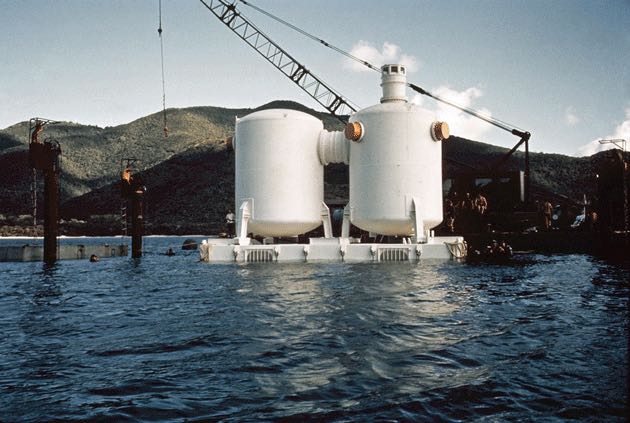
A little-known experiment happened here on St. John in the late 1960s and again in 1970. The project was fascinating and a first of its kind. The Navy, NASA, and the Department of Interior joined forces to create an underwater habitat that allowed scientists to stay submerged in the ocean for an extended period of time. The experiments, dubbed Tektite I and II, were conducted deep in the waters of Great Lameshur Bay on St. John’s south shore. Tektite not only allowed scientists to study marine life in its natural habitat for an extended period of time, but it also allowed them to test how people would react to long missions in an isolated setting. This information would be used to help NASA with regard to its upcoming space flights.
Tektite was an underwater laboratory that consisted of two metal silos, which were connected by a flexible tunnel. The silos were 12-and-a-half feet wide by 18 feet high. The habitat contained bunks, a galley, a shower, and an experiment area among other elements. The habitat, which General Electric built, was placed in 49 feet of water on the ocean floor.

The mission of Tektite I was threefold. The Navy was interested in the study of diving physiology and small-crew psychology for future submersible and saturated diving missions and advances that could be made in ocean technology. The Navy was the lead agency for Tektite I.
NASA’s primary interest in Tektite I was the study of the performance of highly qualified scientists under conditions of stress for use in understanding and predicting man’s behavior on long-duration space flights.
The Department of the Interior wanted to learn about the use of saturated diving to broaden man’s capability to conduct scientific work in the sea.
On February 15th, 1969, four scientists – a fishery biologist, a geologist, and two oceanographers – descended to the ocean floor. They returned to the surface on April 15th, 1969. The experiment set a world record for the longest time a person remained underwater.
The scientists – Ed Clifton, Conrad Mahnken, Richard Waller, and John VanDerwalker – were not limited to the habitat for the 60-day period. During the mission, they spent 432 hours outside their habitat. They swam out on a daily basis to study a variety of sea life, although there was a particular focus on the spiny lobster. They were studying how it moves, eats, and survives in our waters.
Now you may be wondering why the Navy, NASA, and the Department of Interior conducted this experiment on St. John, specifically the Lameshur Bay area. Great Lameshur was chosen because the water is relatively shallow, there are low subsurface water currents in the area, and it is sheltered from potential storms. It was chosen due to the vast diversity of marine plant and animal species, which is enhanced by the extensive coral reefs in the area. Finally, it was chosen due to the logistics supportability.

Tektite I was deemed a success, however, the experiment didn’t end when the four men surfaced in April 1969. A second experiment was conducted the following year, and it, too, set world records. Stay tuned for part two of this story, which will include details on Tetkite II, plus other interesting facts about these experiments and its nearby base camp.
But in the meantime, for those of you who are curious whether any of the structure remains, the answer, sadly, is no. It was removed after the completion of the Tektite II experiment. More on that to come…
Looking to take a St. John island tour?
Learn more here –> www.explorestj.com/tour Full & half days available. Rated “Excellent” on TripAdvisor.
Follow Explore STJ on Social Media
–> www.facebook.com/explorestj
–> www.instagram.com/explorestj


